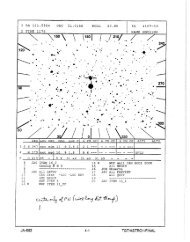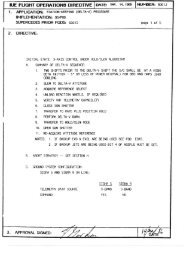The FUSE Archival Data Handbook - MAST - STScI
The FUSE Archival Data Handbook - MAST - STScI
The FUSE Archival Data Handbook - MAST - STScI
Create successful ePaper yourself
Turn your PDF publications into a flip-book with our unique Google optimized e-Paper software.
Chapter 4<br />
<strong>The</strong> Science <strong>Data</strong> Files<br />
This chapter describes the science data files available from the <strong>FUSE</strong> archive. Ancillary data<br />
files, which provide additional information about the state of the instrument and spacecraft,<br />
are described in Chapter 5.<br />
<strong>The</strong> “Casual” user mostly needs to examine <strong>FUSE</strong> preview files and understand their limitations<br />
while the “Intermediate” and “Advanced” users need to be knowledgeable about some<br />
or all of the <strong>FUSE</strong> data files for an observation. Table 4.1 in the next section lists all <strong>FUSE</strong><br />
data file extensions available for download from the <strong>MAST</strong> archive. This table is aimed at<br />
helping all users determine which files are essential to their project and to find the relevant<br />
information throughout this document. It is, therefore, strongly recommended that potential<br />
<strong>FUSE</strong> users read the Overview Section (below) and familiarize themselves with the contents of<br />
these tables before retrieving any data files.<br />
4.1 Introduction to the Science <strong>Data</strong> Files<br />
4.1.1 Overview<br />
A <strong>FUSE</strong> observation is a set of contiguous exposures of a particular target through a specific<br />
aperture. Each exposure generated four raw science data files, one for each detector segment<br />
(1A, 1B, 2A and 2B). <strong>The</strong>re are two pairs of spectra (one LiF and one SiC) for the target on<br />
each detector segment. When all of the data are extracted, 8 calibrated spectra result from a<br />
single exposure. Figures 4.1 and 4.2 show geometrically corrected images of spectra on Side 1<br />
and Side 2 detectors for a single exposure. Observations may consist of any number of exposures<br />
between 1 and (in principle) 999.<br />
Spectra are extracted by Cal<strong>FUSE</strong> only for the target aperture and are binned in wavelength.<br />
<strong>The</strong> default binning is 0.013 ˚A, which corresponds to about two detector pixels, or one fourth<br />
of a point source resolution element. After processing, a series of combined observation-level<br />
spectral files are generated along with a variety of preview files. <strong>The</strong>se files will be discussed in<br />
detail in the next sections.<br />
16




